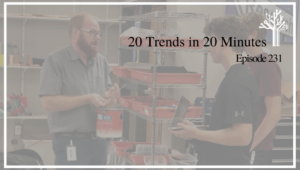12 Trends Killing College

Does college still matter? The Department of Education makes the case that college is more valuable than ever: degree holders earn $1 million more that workers without postsecondary education and the innovation economy is likely to require a more educated workforce. But averages and projections hide the rapid loss of faith in higher education as the escalator to the middle class.
Frustrated with increasing costs and underemployed grads living in their parent’s basement, less than half of American adults have confidence in higher education, a big decline in the last three years according to Gallup.
With this rapid loss of faith in higher ed expensive nonselective colleges are in trouble. A dozen trends have conspired to create the beginning of the end of college as we know it.
1. Declining enrollment. The number of high school graduates peaked in 2013 is flat and will begin to fall in the next decade as a result of lower birth rates. College enrollment has declined since a peak in 2010–2011 putting pressure on many smaller second and third tier schools.
2. End of degree inflation. After several decades of adding degree requirements as a simple screen of ability and persistence, employers are focusing more on skills than pedigree. Google, Apple and a dozen other leading employers stopped requiring degrees for many jobs. Groups like Opportunity@Work have been expanding career opportunities by leading the shift to skills-based hiring.
3. Cheap & sponsored higher education. In 2012, some thought the rise of massively open online courses (MOOC) would transform higher education. It did extend global access to quality content but mostly to degree holders. In the last few years, MOOC providers Coursera, EdX and Udacity have begun offering certificates and degrees creating new low cost competition for second tier institutions.
Community colleges have been offering online courses for 20 years. Most universities followed by offering some programs online. They’ve been joined by the rise of mega universites ASU, Purdue, SNHU and WGU offering affordable, flexible online degree programs.
Education as an employee benefit is on the rise. Starbucks offers access to ASU degree programs. Guild Education helps companies like Disney, Lyft and Walmart offer education as a benefit to employees. Coursera for Business is also offering sponsored education
Cheap or sponsored higher ed will continue to put cost pressure on second and third tier colleges.
4. Alternatives to higher education. A variety of coding bootcamps, training and certification programs—what investor Ryan Craig calls “last mile training programs” are proliferating. As Walton Family Foundation official Bruno Manno said, many good jobs don’t require college.
5. Advocacy bubble. Twenty years of well-intentioned advocacy sent more people to college. Equity advocates (including myself) urged historically underserved groups to get four year degrees because they appeared uniquely valuable. Colleges loved the rush, raised prices and even got another enrollment boost in the Great Recession when millions were out of work. The rush felt good but the underlying value proposition didn’t match the growth—they call that a bubble (see #11 and #12).
Over the last two years, the advocacy pendulum swung back to career and technical education (CTE) with excitement around emerging earn and learn employment ladders (#4) but it remains an open question if this renewed emphasis on CTE can yield equitable results or just retrack high schools.
6. Rising prices. The price of a four-year degree doubled between 1989 and 2016—about eight times faster than wages. That means that each successive cohort of graduates is worse off than the last. In the last decade, tuition at four-year schools in eight states is up more than 60 percent. This doesn’t end well.
A recent poll suggests that 83% of students said affordability was a factor in deciding which college to attend, up from 75% last year. In addition, 71% of students said costs could determine whether to attend college at all—up from last year’s 65%.
7. State disinvestment. One reason tuition increased at public institutions is that state funding for public two and four-year colleges in the 2017 school year was nearly $9 billion below its 2008 level.
Instead of growing a citizenry, critics have argued the rapid public disinvestment in higher education has made it private rather than a public good. “The idea of a university education has moved from being a public good where an educated population benefits the preservation of a healthy democratic society, to the idea of a university education benefits an individual and her ability to get employment,” said UT Arlington professor Geroge Siemens. “Once you have an individual paying like they’re a customer, they’re going to start acting like they’re a customer,” added Siemens.
8. Student loan crisis. More people going to college plus rising costs equals more debt. More than 44 million U.S. borrowers owe $1.7 trillion in student loan debt—more than auto loans and credit card debt combined.
9. Worst case scenario. About a third a people that attempt degrees rack up debt without completing a degree—the new disaster scenario. This trend surfaced in the Great Recession and when combined with the indebted underemployment of many college graduates, began to dampen enrollment and “all students go to college” advocacy.
10. For-profit implosion. Based on weak employment rates and lots of debt without degrees (#9), Secretary Duncan’s team issued tough regulations that killed off hundreds of for-profit colleges. More than 100 colleges closed in the last two years (20 nonprofit colleges shuttered during that period). For-profit enrollment was cut by about 70 percent from 2010-2019.
You’re thinking, “No loss, they were shysters.” But it was the venture-backed R&D lab of higher ed, the most agile purpose-built part of the sector. Now it’s more likely that big postsecondary innovations will come from China or India.
11. Obsolete architecture. It’s quickly becoming a ‘show what you know’ world but colleges are stuck in a courses and credits model—it’s the organizing principle for architecture, schedules and communication. The resulting transcript (i.e., list of courses passed) is a terrible way to describe what a person can actually do.
Reorganizing around capabilities development rather than seat time is a massive undertaking. It means supporting short personalized skill sprints and extended community-connected challenges. It will require new ways to signal new capabilities (comprehensive learner records including badges, certificates and portfolios).
The new architecture of college will also move beyond the confines of a four year degree to a lifelong learning relationship where short sprints prepare learners for new opportunities. The open question is whether the winner in this new race will be a university or Udemey, your alma mater or LinkedIn?
12. Perpetuating inequality. Perhaps most disturbing is that getting to and through college remains highly segregated. A child from the bottom socioeconomic quartile with high test scores in kindergarten has a 3 in 10 chance of having a college education and a good entry-level job as a young adult, compared to a 7 in 10 chance for a child in the top quartile of socioeconomic status who has low test scores. In addition to simply propelling the well-heeled students into careers, the crisis of debt without a degree (and debt with the wrong degree) plagues the bottom income quartiles.
About 10% of universities are highly selective—and they’ll be fine for the foreseeable future (notwithstanding the enrollment scandal which illustrated how inane the admissions process is). Most have big endowments and the perception of value—despite the fact that most don’t deliver on the promise. It’s the expensive second and third tier colleges that are taking a beating. Many are going out of business whether they know it or not.
In the next posts (How to Fix HigherEd and 7 New Rules for Choosing College), we’ll investigate promising solutions to these problems and what you can do to avoid racking up debt without a good job to pay it back.
For more see:
- Promoting Pathways to Good Jobs: Strada Education Network
- College Unbound Helps Working Adults Earn Fast Affordable Degrees
- Engineering Good in the World
This post is a part of the Getting Smart Future of Work Campaign. The future of work will bring new challenges and cause us to shift how we think about jobs and employability — so what does this mean for teaching and learning? In our exploration of the #FutureOfWork, sponsored by eduInnovation and powered by Getting Smart, we dive into what’s happening, what’s coming and how schools might prepare. For more, follow #futureofwork and visit our Future of Work page.
Stay in-the-know with innovations in learning by signing up for the weekly Smart Update.
This post was originally published on Forbes.









0 Comments
Leave a Comment
Your email address will not be published. All fields are required.